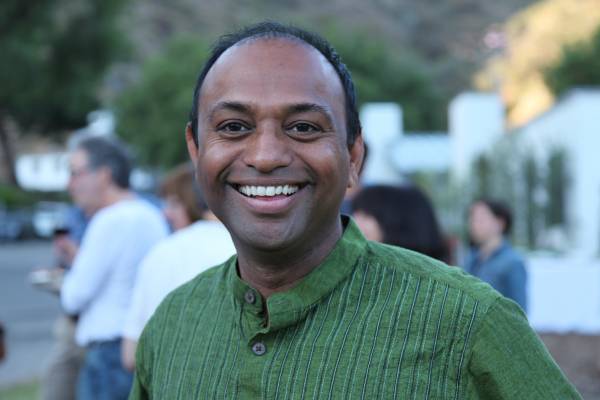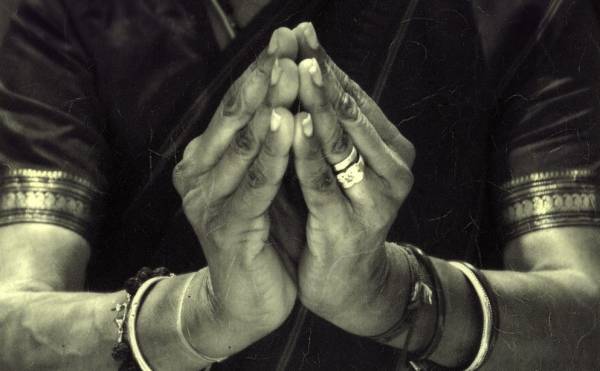Will the real yoga please stand up? This is a question many are asking today as yoga continues to expand as a commercial venture in the United States. According to statistics, $10.3 billion was spent on yoga and yoga-related products in 2012.
Arvind Chitumalla has taken this query to heart. He is on a crusade to bring a more comprehensive understanding of yoga to western practitioners.
Will the real yoga please stand up? This is a question many are asking today as yoga continues to expand as a commercial venture in the United States. According to statistics, $10.3 billion was spent on yoga and yoga-related products in 2012.
Arvind Chitumalla has taken this query to heart. He is on a crusade to bring a more comprehensive understanding of yoga to western practitioners.
Meet Arvind Chitumalla
Born and raised in southern India, Arvind Chitumalla came to the United States just over ten years ago. He described his first yoga class in America as a “culture shock.” He said, “What was obvious was that it was a fitness routine and all the other aspects of yoga were left out.” Arvind felt a calling in that first class to bridge the gap between the yoga he knew in India and the one he found in America.
The Steps
Arvind’s newfound mission initially compelled him to become a yoga studio owner. He opened a studio in Venice, California and one in Santa Monica. In his classes, he focused on the non-asana (non-pose) aspects of yoga such as breath work, meditation, mantra, Sanskrit, and philosophy.
During our interview, Arvind said with a chuckle, “I did not want to teach asana because thousands of others were already doing such a great job of it, and I didn’t feel the need to reinvent the wheel.” At a certain point, though, Arvind felt called to take his message beyond the hundreds he was reaching through his studios.
“‘Once we begin marketing the other parts of yoga, it will open people’s minds to something more than asana and they will begin exploring these other modalities and seeking out the right teachers and schools.'”
Arvind’s next step was the creation of Moksha Festival – a three-day yoga and music festival that includes Ayurveda, sacred music, and healthy food. Moksha is a Sanskrit word meaning freedom from the cycles of birth and death.
With Moksha Festival being established in 2011 and still going strong, Arvind’s outreach grew from hundreds to thousands. Through Moksha, Arvind witnessed firsthand people’s hunger for the deeper aspects of yoga. This inspired him to take his message even further.
Arvind’s New Film: “Yoga Maya”
Currently Arvind is reaching an ever-widening audience with his East-versus-West, gap-bridging wisdom on yoga with his film, Yoga Maya – Unveiling the Illusions of a Sacred Science. The word maya means “misled by matter” or “illusion.” In the film, Arvind explores what he feels are the four most widely held misconceptions about yoga:
- Yoga is asana (poses)
- Yoga is a religion
- 200 hours makes a yoga teacher
- Yoga is tantra
According to the film, these illusions are what keep Western yoga trapped in the physical realm. It was a screening of the documentary film that connected me to Arvind. I was elated to find a film that was exploring some of the concerns I have about yoga’s future and to see senior yoga teachers such as Annie Carpenter, Jai Uttal, and Mark Whitwell share their perspectives. The film makes for a thought-provoking watch for teachers, devoted students, and skeptics.
“Arvind is concerned that the current standards for yoga teachers are a big part of the overall problem shrouding yoga in misconception.”
Arvind hopes the film will inspire people to look beyond the physical aspect of yoga. The film is currently screening at various venues in Southern California and has been selected for festival screenings in India and America. Visit the website for more details.

A New Teaching Model
Yoga Alliance is currently the largest nonprofit association representing the yoga community. Arvind is concerned that the current standards for yoga teachers are a big part of the overall problem shrouding yoga in misconception. This concern led him to begin conversations with Yoga Alliance, which he hoped would bring needed changes. His attempts at change were unsuccessful, though. So Arvind set out on a new course. He founded Yoga Next as the solution to the problem of low and incomprehensive industry standards set by Yoga Alliance.
Born out of a meeting with 35 senior teachers in Southern California, Yoga Next raises the minimum requirement for teacher training to 350 hours and balances the subject matter more evenly among the eight limbs of yoga. The intermediate 500-hour and advanced 750-hour certifications require five years and ten years of teaching experience respectively, as part of the certification requirement. Grandfather clauses do exist to allow for previous trainings, though.
“’There is no better time than now for us to embrace yoga in its entirety.’”
Mentorship, practicum, and online resources are part of the expansive support that Yoga Next offers to the yoga community. It’s hard to believe the registration fee is only $50.00 per year for studios and teachers – a marked difference compared to Yoga Alliance’s complicated and more pricey fee structure.
Yoga Next is a breath of fresh air compared to the stagnant and slow-to-change Yoga Alliance and is indeed the next step for yoga’s progress. If you’re looking to offer or take a teacher training, consider becoming part of Yoga Next’s growing community of yoga teachers (not just asana instructors).
RELATED: How to Maintain Yoga’s Lineage in Modern Times
Advice to Teachers and Studio Owners
Before we parted, I asked Arvind if he had any insights for current teachers and studio owners on how we can contribute to a more holistic understanding of yoga. Here are his suggestions:
- Watch your language. “We should watch the language we use around yoga. For example, to say “I’m having a yoga and meditation class” is an oxymoron. Yoga is meditation.” According to Arvind, verbiage like this confuses many people today about what yoga is and isn’t.
- Market the non-asana aspects of yoga. “Once we begin marketing the other parts of yoga, it will open people’s minds to something more than asana and they will begin exploring these other modalities and seeking out the right teachers and schools.”
- Don’t be afraid to offer more than asana. While everyone else is offering only asana, be the studio (or teacher) that stands out by offering other aspects of yoga. Arvind admonishes studio owners to, “Embrace the thing that you’re running away from.” Trust that people will feel the benefits and return because they want what your offering which differentiates you from other yoga studios.

The Big Picture on Yoga
Arvind’s passion stems from his recognition of what the complete science of yoga has to offer to a world in need. More than once in our conversation, Arvind made the distinction between yoga as the science of self-realization and yoga as a physical fitness regimen. He said:
About twenty million people practice yoga in America today. For most of these people, yoga means asana, the physical postures. Not more than twenty percent of the yoga practitioners incorporate other aspects of yoga into their practice and lifestyle…if these people expand their practice even marginally by embracing other limbs of yoga, they would benefit exponentially in all walks of life.
As Arvind so simply put it, “There is no better time than now for us to embrace yoga in its entirety.”
Photo 3 courtesy of Shutterstock.






